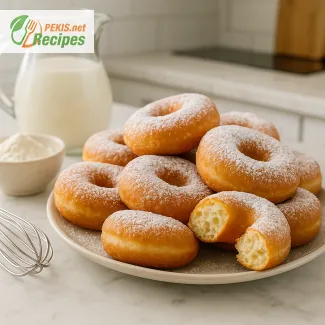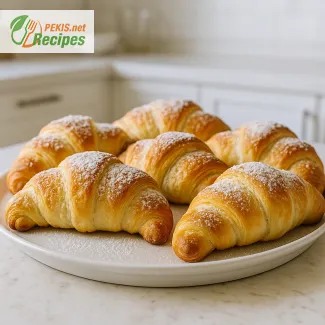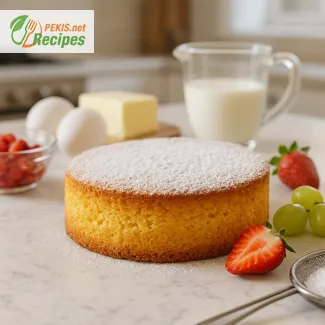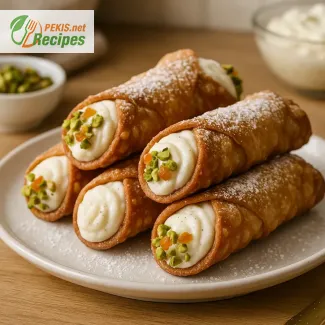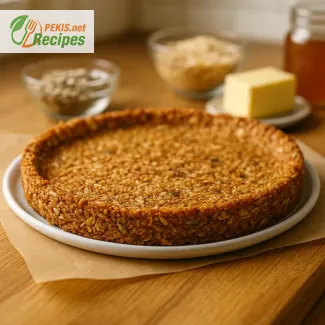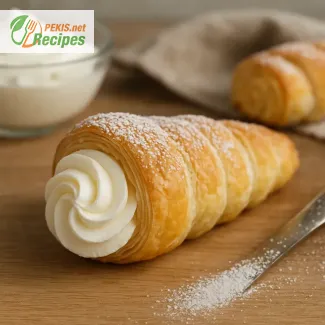
Traditional Baklava Recipe – Authentic and Easy to Make
A Timeless Dessert from the Heart of the Middle East
Few desserts in the world can rival the rich history and irresistible flavor of Baklava. This delicate pastry, composed of crispy layers of phyllo dough, crushed nuts, and a luscious honey-based syrup, has been a beloved treat for centuries. Originating from the Ottoman Empire, Baklava has traveled through different cultures, finding a place in Turkish, Greek, Middle Eastern, and Mediterranean cuisines.
The secret behind perfect Baklava lies in the balance of textures and flavors. The combination of golden, flaky pastry, a nutty filling infused with warm spices, and the sticky-sweet syrup results in a decadent, melt-in-your-mouth experience. Whether served during festive celebrations, family gatherings, or as an indulgent treat with coffee or tea, Baklava is a symbol of hospitality and tradition.
The Art of Making Authentic Baklava
The beauty of homemade Baklava lies in its simplicity. While it may seem intricate, careful layering, high-quality ingredients, and proper baking techniques ensure that every bite is perfectly crisp and deliciously rich. Each region has its own take on Baklava, whether using walnuts, pistachios, or almonds, adjusting the level of sweetness, or incorporating hints of cinnamon, cardamom, or citrus zest for added depth.
The preparation begins with thin sheets of phyllo dough, which must be handled gently to prevent tearing. Each layer is brushed with melted butter, creating a delicate crispiness when baked. A generous layer of finely chopped nuts, combined with subtle spices, is spread between the layers before repeating the process. Once baked to a golden perfection, the Baklava is drenched in a fragrant syrup made of honey, sugar, and citrus, which soaks into the layers, adding the signature sweetness that defines this classic dessert.
A Dessert with a Story
Baklava is more than just a dessert; it is a culinary legacy that has been passed down for generations. In the Ottoman Empire, Baklava was often served in royal courts, symbolizing wealth and refinement. Over time, it became a staple of celebratory feasts, particularly during weddings, religious holidays, and special occasions. Even today, in many cultures, preparing and sharing Baklava is considered an act of love and generosity.
Choosing the Right Ingredients for the Best Flavor
The quality of Baklava relies on the freshness of the ingredients. Using premium nuts, pure butter, and authentic honey can make a significant difference in the final taste. Here are the key components that make Baklava extraordinary:
- Phyllo Dough – Essential for achieving the classic delicate crispiness.
- Nuts (Walnuts, Pistachios, or Almonds) – Each variety brings its own distinctive flavor and texture.
- Butter (or Ghee) – Adds richness and depth to the pastry layers.
- Honey or Sugar Syrup – Provides the signature sticky sweetness.
- Cinnamon, Cardamom, or Citrus Zest – Enhances the aromatic complexity of the dish.
Using a mix of different nuts and spices allows for subtle variations, giving each batch of Baklava a unique and refined character.
Perfect Pairings and Serving Suggestions
Baklava is best enjoyed fresh but can also be stored for several days, allowing the syrup to infuse the layers for even more flavor. It pairs beautifully with:
- Turkish coffee or strong black tea, balancing the sweetness with bold, bitter notes.
- A dollop of Greek yogurt or a scoop of vanilla ice cream, adding a creamy contrast to the crisp layers.
- A sprinkle of crushed pistachios, enhancing both the visual appeal and texture.
A Timeless Classic with Endless Variations
While traditional Baklava follows a time-honored recipe, there are countless ways to customize and experiment with flavors. Some modern variations include:
- Chocolate Baklava – Layers of melted chocolate between the nuts for a decadent twist.
- Coconut Baklava – A blend of coconut flakes with the nuts for an exotic touch.
- Orange Blossom or Rosewater Syrup – A few drops of floral essence for a distinctly Middle Eastern aroma.
- Savory Baklava – Experimenting with cheese and herbs for a completely new take.
The Ultimate Indulgence
Whether you are preparing it for a special occasion or simply to treat yourself, Baklava is a true delight that never fails to impress. The combination of crispy layers, rich nuts, and sweet syrup creates a harmonious balance that lingers long after the last bite. Once you master this authentic recipe, you’ll find yourself making it again and again, savoring the traditions and flavors that make Baklava one of the most beloved desserts worldwide.
- Preheat the oven to 180°C (356°F) using top/bottom heat. Grease a baking dish (approx. 20x30 cm / 8x12 inches) with butter.
- Prepare the nut filling by mixing walnuts or pistachios with sugar, cinnamon, and cardamom.
- Layer the phyllo dough: Place one sheet of phyllo dough in the dish and brush with melted butter. Repeat this process with 6-7 layers.
- Add the filling: Evenly spread half of the nut mixture over the layered phyllo dough.
- Continue layering: Add another 6-7 layers of phyllo dough, brushing each layer with butter. Spread the remaining nut mixture evenly.
- Final layers: Place the last 6-7 layers of phyllo dough on top, brushing each layer with butter.
- Cut before baking: Use a sharp knife to cut the baklava into diamonds or squares before baking.
- Bake for 35-40 minutes until golden brown.
- Prepare the syrup: While the baklava bakes, heat water, sugar, honey, and lemon juice in a saucepan until the sugar dissolves. Add rose water if desired.
- Pour the syrup over the baklava: Immediately after baking, evenly pour the hot syrup over the hot baklava.
- Let it soak: Allow the baklava to rest for at least 4 hours or overnight for the syrup to fully absorb.
How to Perfect Your Traditional Baklava – Tips and Variations
The Art of Crafting Exceptional Baklava
Baklava is a legendary dessert that has been cherished across cultures for centuries. The combination of crispy phyllo layers, rich nut filling, and sweet honey syrup creates an unforgettable balance of textures and flavors. While the traditional recipe remains a favorite, small adjustments can elevate this delicacy to a whole new level. Whether tweaking the nut selection, experimenting with syrups, or adding subtle spices, baklava offers endless possibilities for refinement and personalization.
Choosing the Right Nuts for the Perfect Flavor
The nut filling is at the heart of baklava’s appeal, offering a satisfying crunch and rich flavor. Selecting the right combination of nuts can create a distinctive taste profile:
- Walnuts – The most commonly used nut in baklava, walnuts bring a deep, earthy flavor with slightly bitter undertones. They balance well with the sweetness of the syrup and are ideal for a traditional taste.
- Pistachios – These add a buttery texture and a vibrant green color, making baklava both visually appealing and mildly sweet. Pistachios are often used in Middle Eastern variations for a more refined taste.
- Almonds – With a delicate sweetness, almonds provide a lighter, more subtle nutty flavor that blends well with citrus-based syrups.
- Hazelnuts – Offering a toasty, slightly chocolatey note, hazelnuts create a deeper, more intense flavor profile that pairs beautifully with warm spices.
For a more complex flavor, consider using a blend of two or three different nuts, finely chopping them to maintain the signature texture.
Butter or Ghee – Which Works Best?
The choice of fat in baklava affects its richness and crispiness. Each option offers a slightly different result:
- Unsalted Butter – The classic choice, giving baklava its rich and slightly caramelized taste.
- Ghee (Clarified Butter) – Provides a deeper, nuttier flavor and ensures that the phyllo stays extra crisp without any risk of burning.
- Olive Oil or Nut Oils – A lighter alternative for those looking to reduce dairy content while enhancing the nutty flavor. Using almond or pistachio oil can subtly intensify the filling’s taste.
Brushing each layer evenly is crucial to achieving that perfect golden crispness. Be careful not to oversaturate, as too much butter can make the pastry heavy instead of flaky.
Enhancing the Syrup – Finding the Right Balance
The syrup is key to achieving the perfect texture. A well-balanced syrup ensures that baklava is moist but not soggy, with a deeply aromatic sweetness. Small modifications can create entirely different flavor profiles:
- Honey-based syrup – Adds a natural, floral sweetness, ideal for a more authentic, rich taste.
- Citrus-infused syrup – Lemon or orange zest can bring a fresh, tangy contrast to the sweetness.
- Rose or Orange Blossom Water – Just a few drops of floral essence can add a Middle Eastern touch, elevating the complexity of flavors.
- Cinnamon or Clove Syrup – For a spicier, deeper warmth, infuse the syrup with whole spices during preparation.
The Secret to Perfectly Layered Phyllo
Phyllo dough is delicate and must be handled with care to achieve the crisp, flaky texture baklava is known for. Here are key tips to ensure success:
- Keep phyllo sheets covered with a damp cloth to prevent drying out.
- Brush each layer lightly to maintain a balance between crispness and structure.
- Pre-cut the baklava before baking to allow the syrup to penetrate evenly without shattering the layers.
Layering too many sheets without butter can result in a dense pastry, while not using enough layers will make the baklava too thin and fragile.
Creative Variations to Try
While traditional baklava remains a beloved classic, there are modern interpretations that introduce exciting new flavors:
- Chocolate Baklava – A decadent version that includes layers of dark chocolate or cocoa-infused nuts, giving a subtle bitterness that balances the sweetness.
- Coconut Baklava – Replacing part of the nuts with shredded coconut adds a tropical, slightly chewy texture.
- Spiced Baklava – Incorporating nutmeg, cinnamon, and cardamom into the nut mixture creates a warmer, more aromatic flavor.
- Savory Baklava – For an unconventional twist, cheese and herbs can replace the syrup, turning baklava into a flaky, buttery appetizer.
Serving Baklava for Maximum Enjoyment
Baklava tastes best when allowed to rest overnight, allowing the syrup to fully absorb into the layers. Serve it warm or at room temperature for the best texture and flavor.
- Paired with Turkish coffee or strong black tea, baklava’s sweetness is balanced by bold, bitter notes.
- A side of Greek yogurt or vanilla ice cream provides a creamy contrast to the crisp pastry.
- A final garnish of crushed pistachios enhances the visual appeal and adds an extra crunch.
The Perfect Baklava is Within Reach
Mastering baklava is about understanding the balance of textures, flavors, and layering techniques. By experimenting with different nuts, syrups, and spices, you can create a personalized version of this timeless dessert. Whether staying true to tradition or adding a modern twist, baklava remains a symbol of indulgence, hospitality, and culinary craftsmanship.
Contains nuts, butter, and gluten (phyllo dough made from wheat flour).
Substitutions for Allergies:
- Gluten-free: Use gluten-free phyllo dough or rice paper as a substitute.
- Dairy-free: Replace butter with melted coconut oil or margarine.
- Nut-free: Swap nuts for toasted coconut flakes or sunflower seeds.
- Vitamin E (1 mg per serving): Supports skin health and strengthens the immune system.
- Magnesium (20 mg per serving): Helps muscle relaxation and supports the nervous system.
- Iron (0.7 mg per serving): Essential for oxygen transport in the blood.
- Potassium (100 mg per serving): Regulates fluid balance and supports heart function.
- Polyphenols from nuts (40 mg per serving): Have anti-inflammatory properties and protect cells from oxidative stress.
- Flavonoids from cinnamon (15 mg per serving): Improve blood circulation and enhance insulin sensitivity.
- Vitamin C from lemon juice (2 mg per serving): Supports the immune system and collagen production.
